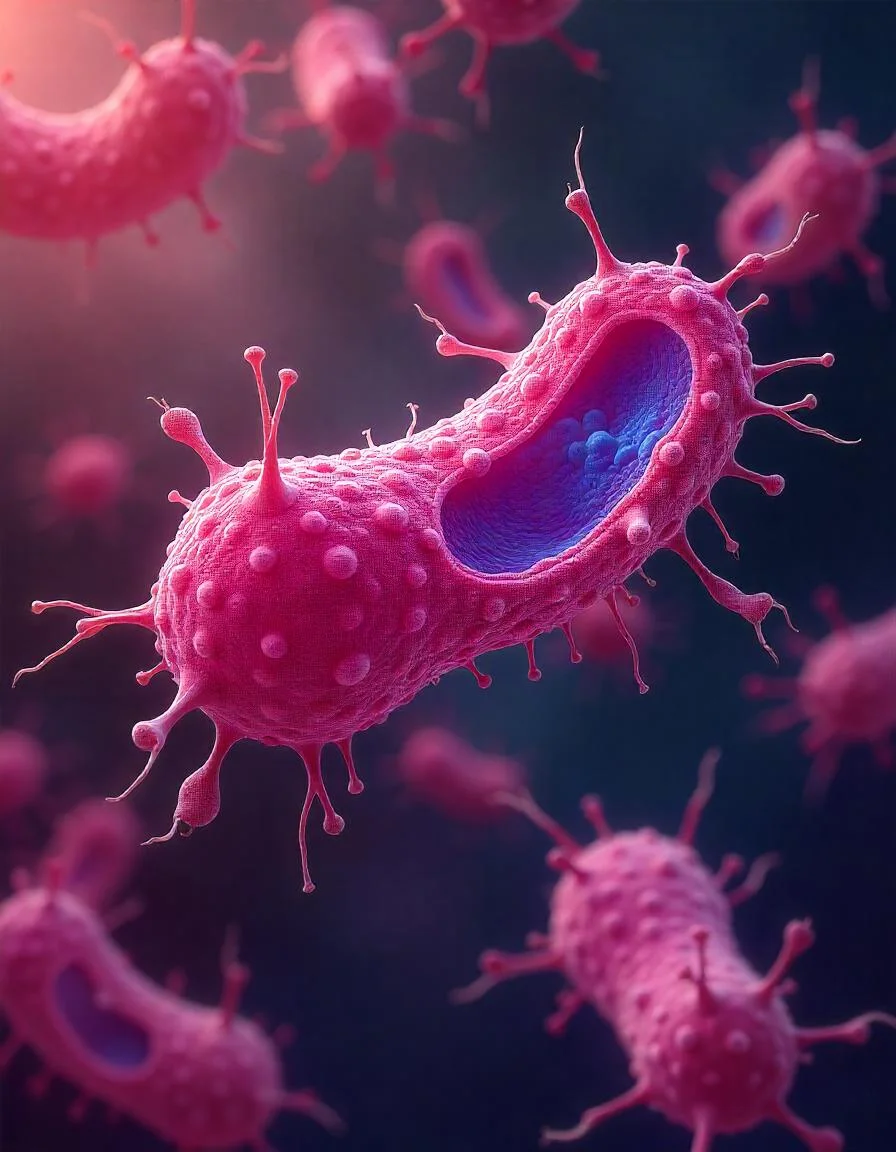Introduction to Mikoplazmos
Mikoplazmos, or mycoplasmas, are a fascinating group of bacteria that lack a cell wall, making them unique among microorganisms. These tiny, free-living organisms are among the smallest known to science and are capable of causing a range of infections in humans, animals, and plants. In this article, we will delve into the biology of mikoplazmos, their role in various health conditions, how they are diagnosed and treated, and the importance of prevention. We’ll also explore the growing concerns about antibiotic resistance and the environmental impacts these bacteria may have. For more insights on the global health challenges, you can explore the global health implications.
Understanding the Biology of Mycoplasmas
Mycoplasmas, or mikoplazmos, are distinct because of their lack of a cell wall. Most bacteria have a rigid cell wall that provides structure and protection. In contrast, mycoplasmas have a flexible cell membrane that allows them to take on various shapes, which is referred to as pleomorphism. This flexibility gives them the ability to adapt to different environments, making them highly versatile.
The size of mycoplasmas ranges from 0.2 to 0.3 micrometers, which is incredibly small, even smaller than many other bacteria. This size allows them to slip through filters designed to catch larger organisms. Despite their tiny size, mikoplazmos can be incredibly complex in terms of their genetic material and ability to cause infection.
Key Types of Mikoplazmos
There are several species of mikoplazmos that affect different organisms, from humans to plants. Some of the most significant ones include:
- Mycoplasma pneumoniae: This species is most commonly associated with respiratory infections in humans, often leading to conditions such as “walking pneumonia.”
- Mycoplasma genitalium: Linked to urogenital infections, this bacterium can cause conditions like pelvic inflammatory disease (PID) and is also associated with sexually transmitted infections.
- Mycoplasma hyopneumoniae: A key player in respiratory diseases in pigs, it has significant implications in agriculture, particularly in the swine industry.
Each of these species can cause different health issues, ranging from mild infections to chronic diseases.
Mikoplazmos in Human Health: The Role They Play
Mikoplazmos are known to cause a variety of health issues in humans, particularly in the respiratory and urogenital systems. Understanding the symptoms and how these infections develop is crucial for diagnosis and treatment.
Symptoms of Mycoplasma Infections
- Incomplete Upper Respiratory Tract Infection: Mycoplasma pneumonia
- Persistent dry cough
- Fatigue and body aches
- Sore throat
- Mild fever
- Headaches and muscle pain
Mycoplasma pneumonia is often referred to as “walking pneumonia” because it tends to be less severe than other types of pneumonia. However, it can last for weeks, leading to exhaustion and discomfort. Diagnosis typically requires specific tests, such as serology or PCR, due to the difficulty in distinguishing mycoplasma infections from other respiratory conditions.
- Incomplete Genital Tract Infections: Mycoplasma genitalium
- Painful urination (dysuria)
- Abnormal discharge from the genital tract
- Lower abdominal pain (in women)
- Pain during sexual intercourse
Mycoplasma genitalium is an emerging concern in the field of sexually transmitted infections (STIs). It can cause pelvic inflammatory disease (PID), which, if untreated, may lead to infertility. Asymptomatic infections are common, making routine screening essential, especially in sexually active individuals.
Diagnosing Mikoplazmos Infections
Diagnosing mikoplazmos infections can be challenging due to the unique characteristics of these bacteria. Traditional bacterial cultures may not be effective since mycoplasmas do not grow well in regular laboratory settings. Therefore, healthcare providers rely on more advanced methods such as:
- Polymerase Chain Reaction (PCR): This test detects mycoplasma DNA in biological samples, offering a highly accurate way to confirm infection.
- Serological Tests: These tests measure the body’s immune response to mycoplasma infections by detecting antibodies in the blood.
- Culture Techniques: While not always reliable, these techniques can sometimes be used to isolate mycoplasmas under controlled laboratory conditions.
Early detection is key to effective treatment, especially since many mikoplazmos infections can remain asymptomatic or present with mild symptoms.
Treatment Options for Mikoplazmos Infections
Treating mikoplazmos infections can be tricky because these bacteria lack a cell wall, making them resistant to many common antibiotics. This is a significant challenge since most antibiotics, like penicillin, target the cell wall. However, there are still effective treatment options available:
- Macrolides: Antibiotics like azithromycin and clarithromycin are often prescribed for respiratory mycoplasma infections.
- Tetracyclines: Doxycycline is commonly used to treat genital mycoplasma infections.
- Fluoroquinolones: Drugs like levofloxacin are used when other antibiotics are not effective or appropriate.
While these antibiotics can be effective, the rise in antibiotic resistance poses a significant challenge. Therefore, the responsible use of antibiotics is essential to avoid resistance and ensure that treatments remain effective.
Preventing Mikoplazmos: Best Practices
Preventing mycoplasma infections requires a multifaceted approach. Since these infections can be transmitted through respiratory droplets or sexual contact, practicing good hygiene and safe sexual practices can significantly reduce the risk of infection.
- Hand hygiene: Washing hands regularly, especially after coughing or sneezing, can help prevent the spread of respiratory mycoplasma infections.
- Safe sexual practices: Using condoms can reduce the likelihood of transmitting mycoplasma infections through sexual contact.
- Avoid sharing personal items: Items such as water bottles, utensils, and towels should not be shared to minimize the spread of bacteria.
Additionally, maintaining a healthy lifestyle with a balanced diet, regular exercise, and adequate sleep can strengthen the immune system, making the body more resilient against infections.
Global Epidemiology and Public Health Implications
Mikoplazmos infections are not limited to one geographic area—they are a global concern. In recent years, the prevalence of mycoplasma infections, particularly those caused by Mycoplasma pneumoniae and Mycoplasma genitalium, has been increasing. In both developed and developing countries, there is a growing awareness of the need for better screening, more research, and public health strategies to address these infections.
The rising prevalence of antibiotic-resistant strains is also a significant concern. Public health initiatives that focus on the responsible use of antibiotics, better diagnostic tools, and global surveillance will be essential to controlling the spread of these infections.
Mikoplazmos and the Environment: Agricultural Impact
In agriculture, mikoplazmos can cause significant damage to plant health, leading to crop losses and economic challenges. Mycoplasma-like organisms are responsible for various plant diseases, which can affect crop yields and reduce food security. Understanding how these bacteria interact with plant hosts and other microorganisms is crucial for developing management strategies in agriculture.
Future Directions in Mikoplazmos Research and Treatments
The study of mikoplazmos is ongoing, and new research continues to uncover the complexities of these unique bacteria. Researchers are exploring new treatment options, including novel antibiotics and alternative therapies, to combat mycoplasma infections. There is also a growing interest in understanding how mycoplasmas evolve and develop resistance to existing drugs.
As we continue to learn more about mikoplazmos, the hope is that we will develop more effective treatments and preventive measures to mitigate their impact on human health, agriculture, and the environment. To stay updated on emerging research, visit resources like 5StarsStocks.
Conclusion: The Need for Ongoing Research and Awareness
Mikoplazmos, while small and often overlooked, have a significant impact on both human health and the environment. From respiratory infections to chronic diseases and agricultural challenges, the need for continued research and better public health strategies is clear. By improving awareness, encouraging early diagnosis, and promoting responsible antibiotic use, we can work towards minimizing the impact of these unique bacteria on our lives.
Frequently Asked Questions (FAQs) About Mikoplazmos
1. What are Mikoplazmos (Mycoplasmas)?
Mikoplazmos, also known as mycoplasmas, are a unique group of bacteria that lack a cell wall. This absence allows them to take on various shapes and sizes. They are the smallest free-living organisms known and can cause a range of diseases in humans, animals, and plants.
2. How do Mikoplazmos affect human health?
Mikoplazmos can lead to several health issues in humans. The most common are respiratory infections, such as walking pneumonia caused by Mycoplasma pneumoniae. They can also cause urogenital infections, particularly from Mycoplasma genitalium, which is associated with pelvic inflammatory disease (PID) and other sexually transmitted infections.
3. How are Mikoplazmos infections diagnosed?
Diagnosing mikoplazmos infections can be difficult due to their unique characteristics. Common diagnostic methods include:
- Polymerase Chain Reaction (PCR): Detects mycoplasma DNA in biological samples.
- Serological Tests: Measures the immune response by detecting antibodies.
- Culture Techniques: Though challenging, some mycoplasmas can be cultured under specific laboratory conditions.
4. What are the symptoms of Mikoplazmos infections?
The symptoms of mycoplasma infections can vary depending on the affected area. Common signs include:
- Respiratory infections: Persistent dry cough, fatigue, mild fever, and sore throat.
- Urogenital infections: Painful urination, abnormal genital discharge, and pelvic pain (in women).
5. Can Mikoplazmos infections be treated?
Yes, Mikoplazmos infections can be treated with antibiotics. However, because these bacteria lack a cell wall, common antibiotics like penicillin are ineffective. Treatment often includes:
- Macrolides (e.g., azithromycin)
- Tetracyclines (e.g., doxycycline)
- Fluoroquinolones (e.g., levofloxacin)
6. How can Mikoplazmos infections be prevented?
Preventing mycoplasma infections involves maintaining good hygiene practices, such as regular hand washing and using condoms during sexual activity. Additionally, avoiding the sharing of personal items, such as water bottles or utensils, can help prevent the spread.
7. Are there any risks associated with antibiotic resistance in Mikoplazmos?
Yes, antibiotic resistance is a growing concern with Mikoplazmos. As these bacteria evolve, some strains are becoming resistant to the antibiotics commonly used to treat them. This highlights the importance of responsible antibiotic use and the need for ongoing research to develop new treatments.
8. How do Mikoplazmos affect agriculture?
Mikoplazmos also impact agriculture, as certain species are responsible for diseases in plants. These bacteria can harm crops, reducing yields and affecting food security. Understanding their role in agriculture is critical for developing better management practices and improving crop health.


